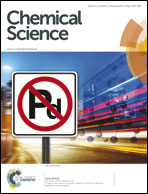Synthesis and energetics of Tp′Rh[P(OMe)3](R)H: a systematic investigation of ligand effects on C–H activation at rhodium†
Abstract
The thermal precursor Tp′Rh[P(OMe)3](Me)H was used to generate the active [Tp′Rh[P(OMe)3]] fragment, which activates C–H bonds of various hydrocarbons to form products of the type Tp′Rh[P(OMe)3](R)H (Tp′ = tris-(3,5-dimethylpyrazolyl)borate). Only one single activation product was observed in each case. The structures of Tp′Rh[P(OMe)3](R)X (X = H, Br, Cl) have been characterized by NMR spectroscopy, elemental analysis, and X-ray crystallography. The kinetics of reductive elimination of RH from Tp′Rh[P(OMe)3](R)H as well as competition experiments between substrates allow measurement of the Rh–C bond strengths relative to the Rh–Ph bond strength. Two separate linear correlations of the Rh–C bond energies versus H–C bond energies were found based on whether the alkyl group is α-substituted or not. While the correlation for α-substituted substrates gives a slope of 1.45, smaller than the slope (1.55) for unsubstituted hydrocarbons, the Rh–C bond energies of the former group are higher by ∼7 kcal mol−1. In comparison with the analogous [Tp′Rh(PMe3)] and [Tp′Rh(CNneopentyl)] systems, replacing the spectator ligand with a more electronic donating group slightly increases metal–carbon bond strengths as the trend in slopes of the correlations follows an order of CNneopentyl < P(OMe)3 ≤ PMe3.
H: a systematic investigation of ligand effects on C–H activation at rhodium](/en/Image/Get?imageInfo.ImageType=GA&imageInfo.ImageIdentifier.ManuscriptID=C3SC52748D&imageInfo.ImageIdentifier.Year=2014)
- This article is part of the themed collection: Celebrating the 2017 RSC Prize and Award Winners

 Please wait while we load your content...
Please wait while we load your content...